A city in which historical sites are interspersed among scenic parks and trendy 21st century establishments, Gyeongju, once the capital of the Silla Kingdom (57 B.C.-A.D. 935), burnishes its reputation as a “museum without walls.”
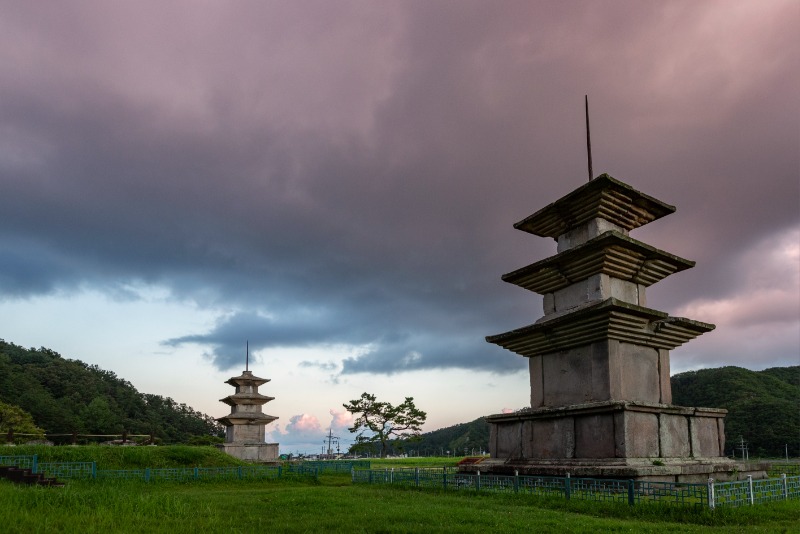
The 13.4-meter-high, three-story stone pagodas at Gameun Temple site in Yongdang-ri, Gyeongju, are the tallest pagodas of the Unified Silla period. Overlooking the sea east of Gyeongju, these pagodas are all that remain of the ancient temple, which was built after King Munmu of Silla unified the Three Kingdoms in the seventh century. The twin pagodas are designated National Treasure No. 112.
As I eagerly set out for Gyeongju, the cradle of Korea’s Buddhist culture, I recalled Jack Kerouac (1922-1969), the iconic American writer and pioneer of the Beat Generation who embraced Buddhism. I would once again be borrowing the name of his seminal 1957 novel, “On the Road.”
Gyeongju was the capital of the Silla Kingdom, which expanded by subduing rival states to rule two-thirds of the Korean peninsula between the seventh and 10th centuries. In its halcyon period, Gyeongju was the fourth-largest city in the world, with an estimated one million inhabitants, and its grandeur was comparable to that of Constantinople (Istanbul), Changan (Xian, China) and Baghdad. Indeed, apart from the Roman Empire and the dynasties of Egypt, there are few countries in human history that have lasted for as long.
Silla adopted a broad perspective, building up an unmistakable global profile. Its ruling elite actively engaged with China, which traded with Arab and European nations via the ancient Silk Road. This explains the Roman glass that has been excavated from some Silla tombs. In Korea, which has seen much of its territory repeatedly obliterated by imperialism and war, we can only be thankful that vestiges of Silla’s resplendent civilization remain today in the southeastern corner of North Gyeongsang Province, some 70 kilometers north of Busan.
Global Profile
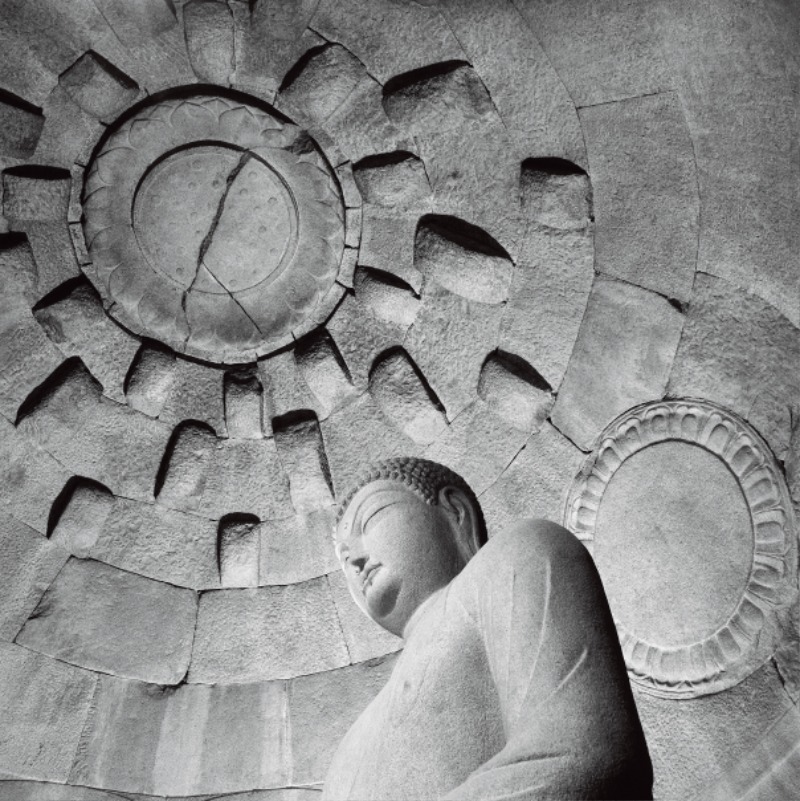
Beyond the antechamber and corridor are the most celebrated works of ancient Korean Buddhist sculpture: a rotunda that represents a lotus blossom, a seated Buddha image, and various Buddhas, bodhisattvas and devas carved into the walls. For preservation purposes, visitors can only appreciate the marvelous Buddhist pantheon from behind a glass wall. © National Research Institute of Cultural Heritage, Han Seok-hong
It had been a long time since I last visited this ancient city. So, like a foreign explorer riding in by boat, I approached Gyeongju from the eastern shore via the ruins of Gameun Temple. The name “Gameun” reflects the idea of being “moved by grace,” specifically the grace of King Munmu (r. 661-681), who completed the unification of the Three Kingdoms. He began construction on the temple in hopes of blocking Japanese invaders with the mercy of the Buddha, but died before its completion. In his will, he asked for his ashes to be buried in the East Sea – and indeed, his wish was fulfilled – so he could return as a dragon to protect the country.
Today, the site of the temple isn’t steeped in hype the way other historic spots in and around Gyeongju are. It may even seem rather neglected. There are no entrance fees, nor was any supervisor or manager in sight during my visit. The ruins include little more than a pair of three-story granite pagodas and the underground remains of some temple structures, but the majestic grandeur of the pagodas is arresting. In ancient times, the sea licked just below Gameun Temple, underneath the floor of the main hall. There was a channel for the king-turned-dragon to enter and leave. Who knows whether the two pagodas protected the dragon, or the dragon protected the pagodas?
The sarira reliquaries discovered inside the pagodas when they were dismantled for restoration are replete with the delicacy of Silla’s metal art. These s, now housed at the National Museum of Korea in Seoul, are unbelievably beautiful. It’s as if these treasures, once ensconced deep inside the pagodas to stay invisible, laid the groundwork for the glorious Silla civilization. They have a modesty that’s luminous but outwardly inconspicuous, teaching us that true beauty needs no packaging – it shines on its own.

The seated Buddha statue of Seokguram Grotto, in Gyeongju, is considered a masterpiece of Buddhist art. Seokguram is a granite cave temple built on the mid-slope of Mt. Toham in the eighth century, with Greek and Roman architectural styles introduced to Korea via the Silk Road. © National Research Institute of Cultural Heritage, Han Seok-hong
Enigmatic Splendor
Wanting to see more of Silla’s mysterious beauty, I headed straight for the heart of Gyeongju. Ahead was Mt. Toham, which blocks the sea winds that blow toward the city. Four kilometers eastward, overlooking the East Sea, was Seokguram, a mountainside grotto hermitage of Bulguk Temple. Seokguram and Bulguk Temple are undisputed choices when exploring the beauty of Gyeongju. In 1995, they were among the first five Korean sites inscribed on the UNESCO World Heritage List. In 2000, an additional series of five historic areas around Gyeongju also became World Heritage sites.
Seokguram, completed in 774, is the acme of Buddhist art and architecture. Reminiscent of the Pantheon in Rome, the grotto chapel is a stunning testimony to the architectural exchange that existed between regions and religious beliefs in ancient times. The area is covered in white granite that was unsuitable for making into a cave and carving images upon, so an artificial grotto was built by assembling hundreds of pieces of granite. This differentiates Seokguram from Buddhist grottos in India or China, and imparts its distinctive beauty.
The grotto features scores of skillfully carved figures representing its Buddhist tenants. Past an arched entrance, antechamber and narrow corridor lies a rotunda housing a Buddha that stands 3.5 meters high, with a realistic, serene appearance. Sitting cross-legged in meditation on a raised, lotus-engraved pedestal, this image of Sakyamuni is recognized as a masterpiece of Buddhist art. Above his head is a dome, also in lotus design; its construction is another example of Greco-Roman influence.
Much of the grotto is now covered for protection. What remains visible can only be seen in passing in a long queue, but I found it enough to be awestruck by the sublime beauty of the sculptural art. The s seemed to instantly burn themselves into my mind’s eye.
Bulguk Temple is located about 15 kilometers southeast of Gyeongju. Known as the “Temple of the Buddha Land,” its history traces back to 528. It is a head temple of the Jogye Order of Korean Buddhism, the largest Buddhist sect in Korea, and is classified by the Korean government as Historic and Scenic Site No. 1. It is also regarded as the prime jewel of the pinnacle of Buddhism in Silla.
In the temple’s main courtyard, Dabotap (Pagoda of Many Treasures) and Seokgatap (Sakyamuni Pagoda) face the main hall, Daeungjeon (Hall of the Great Hero). Discovered inside Seokgatap was a copy of the Great Dharani Sutra, which demonstrates the quality of Silla’s woodblock printing. The pagodas, registered as National Treasures, and the elaborate stone terraces forming the foundation of the temple grounds are the only original structures that remain. The rest has been reconstructed over the ages.
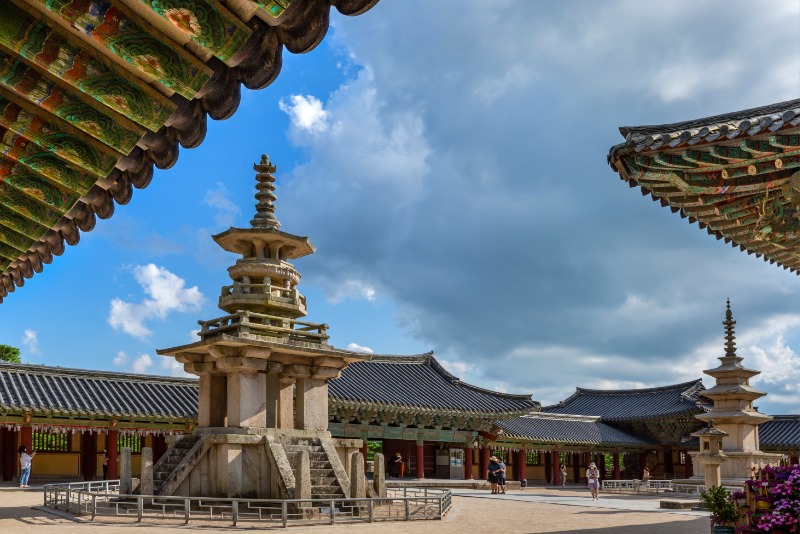
Bulguk Temple at the foot of Mt. Toham features a famous pair of pagodas – Dabotap (Pagoda of Many Treasures), seen in the foreground, and Seokgatap (Sakyamuni Pagoda) – standing in the main courtyard. The temple and Seokguram Grotto represent the apex of Silla Buddhist art. In 1995, they were among Korea’s first five sites inscribed on the UNESCO World Cultural Heritage List.
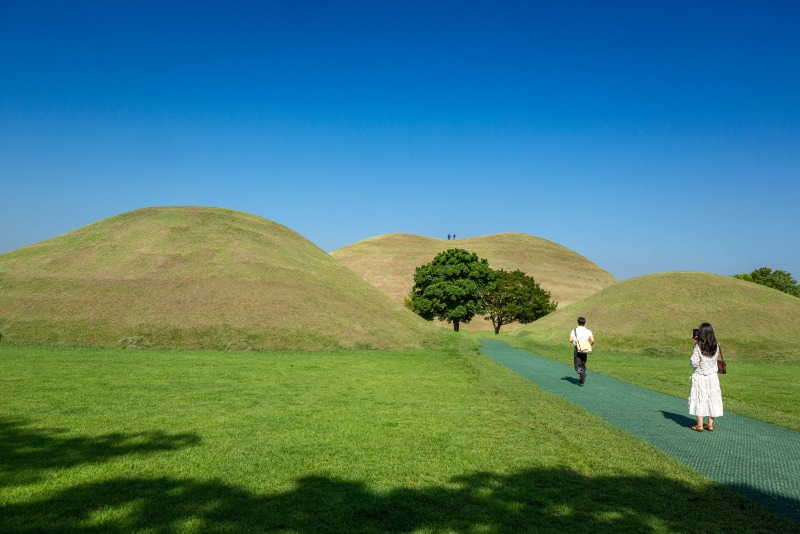
Daereungwon is a sprawling complex of some 125,400 square meters, containing 23 tumuli, the largest group of ancient tombs in Gyeongju. Located in Hwangnam-dong, the heart of the ancient city, its mesmerizing aura transcends time and place.
Are life and death in harmony or disharmony? How should we understand the chasm between modernity and antiquity? Such ubiquitous distinctions alone make Gyeongju sufficiently unique.
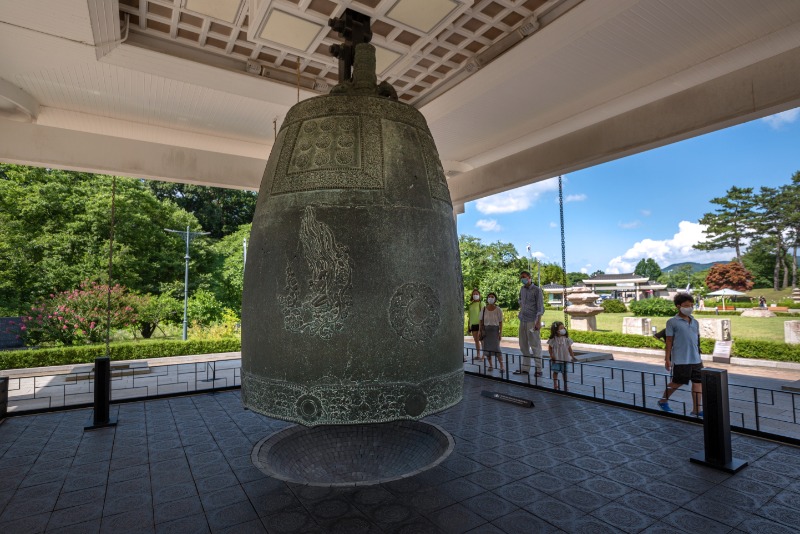
The Divine Bell of King Seongdeok, made in the eighth-century Unified Silla period, is the largest extant bell in Korea. It is 3.66 meters high, 2.27 meters in diameter around the mouth, 11-25 centimeters thick, and weighs 18.9 tons. The sound tube at the top, unique to Korean bronze bells, helpsa deep, resonant sound. The surface of the bell is decorated with exquisite patterns, including flying apsaras.
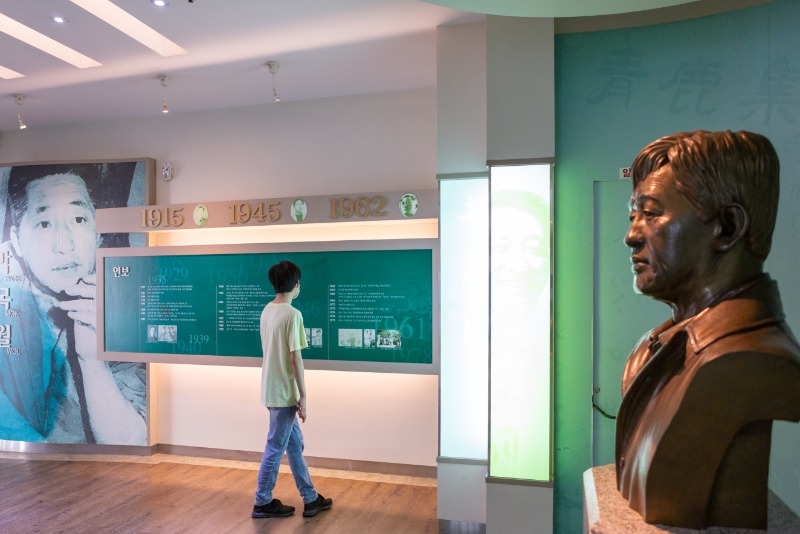
The Dong-ni Mok-wol Literary Museum commemorates two famous Gyeongju natives, novelist Kim Dong-ni (1913-1995) and poet Park Mok-wol (1916-1978), who left indelible marks on modern Korean literary history. The museum offers tours to their birthplaces and sites that served as backgrounds of their works
Books, Burials and Bell
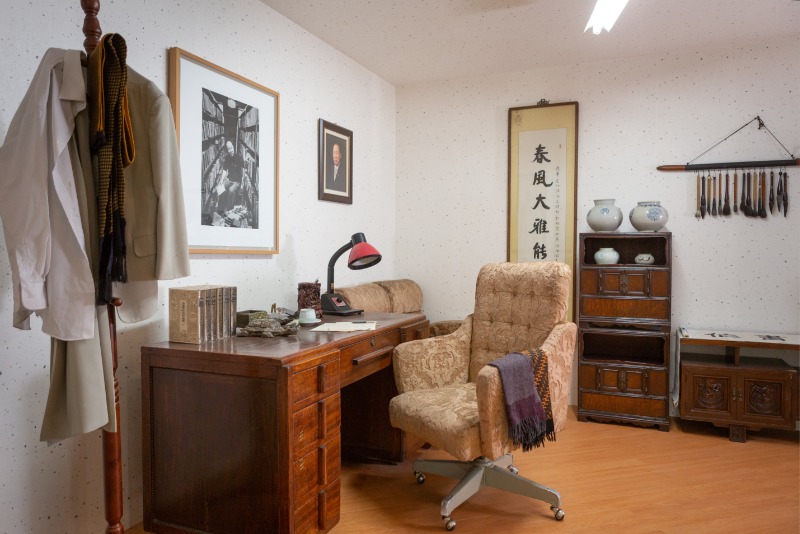
Recreation of novelist Kim Dong-ni’s workspace. The museum devotes separate galleries to Kim and Park, where their respective images and personal items are exhibited.
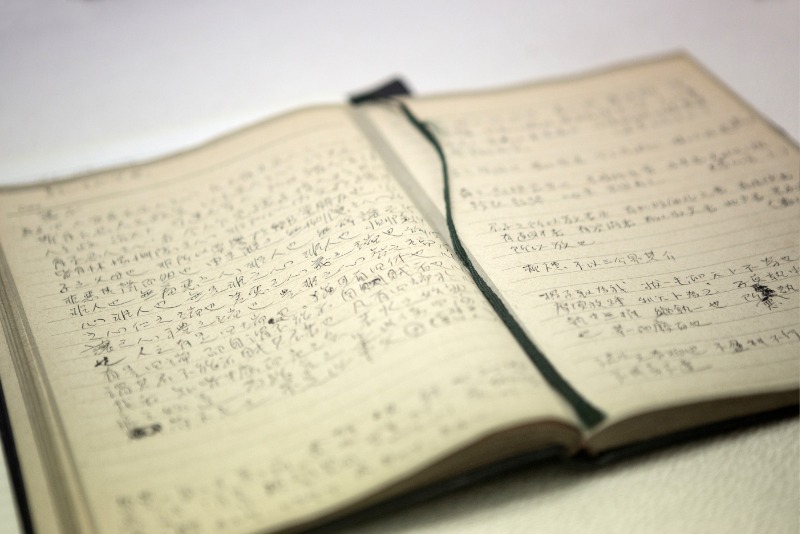
One of Kim’s manuscripts displayed in the recreation of his workspace.
Leaving the temple overwhelmed by the scale and depth of time and space reflected in the ancient relics, I came upon the Dong-ni Mok-wol Literary Museum, which honors novelist Kim Dong-ni (1913-1995) and poet Park Mok-wol (1916-1978). Both were Gyeongju natives and bequeathed beautiful works. At the museum, I recalled the inscription on the Divine Bell of King Seongdeok, a great temple bell crafted in 771 during the Unified Silla period, which includes this line: “The people of those days disdained riches and respected literary talent.”
I heard a poem being recited in the gallery dedicated to Park Mok-wol. The lyricism of the poet reveals a concentrated insight into life and nature, echoing the English poet William Wordsworth. In this way, cultural artifacts are not the only treasures of Gyeongju. In addition to the museum, visitors can take tours that include the authors’ birthplaces and locations that inform the background of their works.
Leaving the literary museum, I took refuge in Cheonmachong, or the Tomb of the Heavenly Horse, at the Daereungwon tumuli park. My toes suddenly felt cold. I was so engrossed with the wonderful sights that I’d failed to notice that my feet were wet from the rain that had fallen all day. The park includes 23 mounded tombs that resemble small, grassy hills. In and around Gyeongju are several hundred tumuli, 35 of which are presumed to be the tombs of Silla kings.
I had imagined the inside of the royal burial chamber would be either dreary or frightening and mysterious, but it was beautiful. When I thought of the labor that had been mobilized to build the tombs and the care put into conducting funeral rites with all the ornate trappings, I marveled at the diligence of these ancient people.
My next destination was the downtown Hwangnam-dong area. The disparity between the ancient tumuli and the urban strip felt slightly disorienting. It was tantamount to recognizing life right from where I had just perceived death. Are life and death in harmony or disharmony? How should we understand the chasm between modernity and antiquity? Such ubiquitous distinctions alone make Gyeongju sufficiently unique.
To wrap up my short visit, I headed for the Divine Bell of King Seongdeok, which is housed in a pavilion on the grounds of the Gyeongju National Museum. This was the enigmatic piece I had most wanted to see. Though half abraded, that exquisite line in the inscription on the bell, memorializing a great king by saying that people during his reign disdained riches and respected literary talent, seemed vividly projected, like a hologram. The bell emits a sublime sound with a deep resonance; Silla’s bell makers appear to have fully understood the theory of wave mechanics. The powerful reverberations might even be the ceremonial roar of a dragon, amazed at its own brilliance, as it protects the numerous sites and artifacts that exemplify the beauty of this city.
Gyeongju remained an important regional stronghold during the dynasties that followed Silla. I felt the city’s old splendor and glory, as well as the beauty entrenched in something that has endured through the ages. I also felt the greatness of the hearts and minds of those who endeavored to safeguard their cultural heritage.